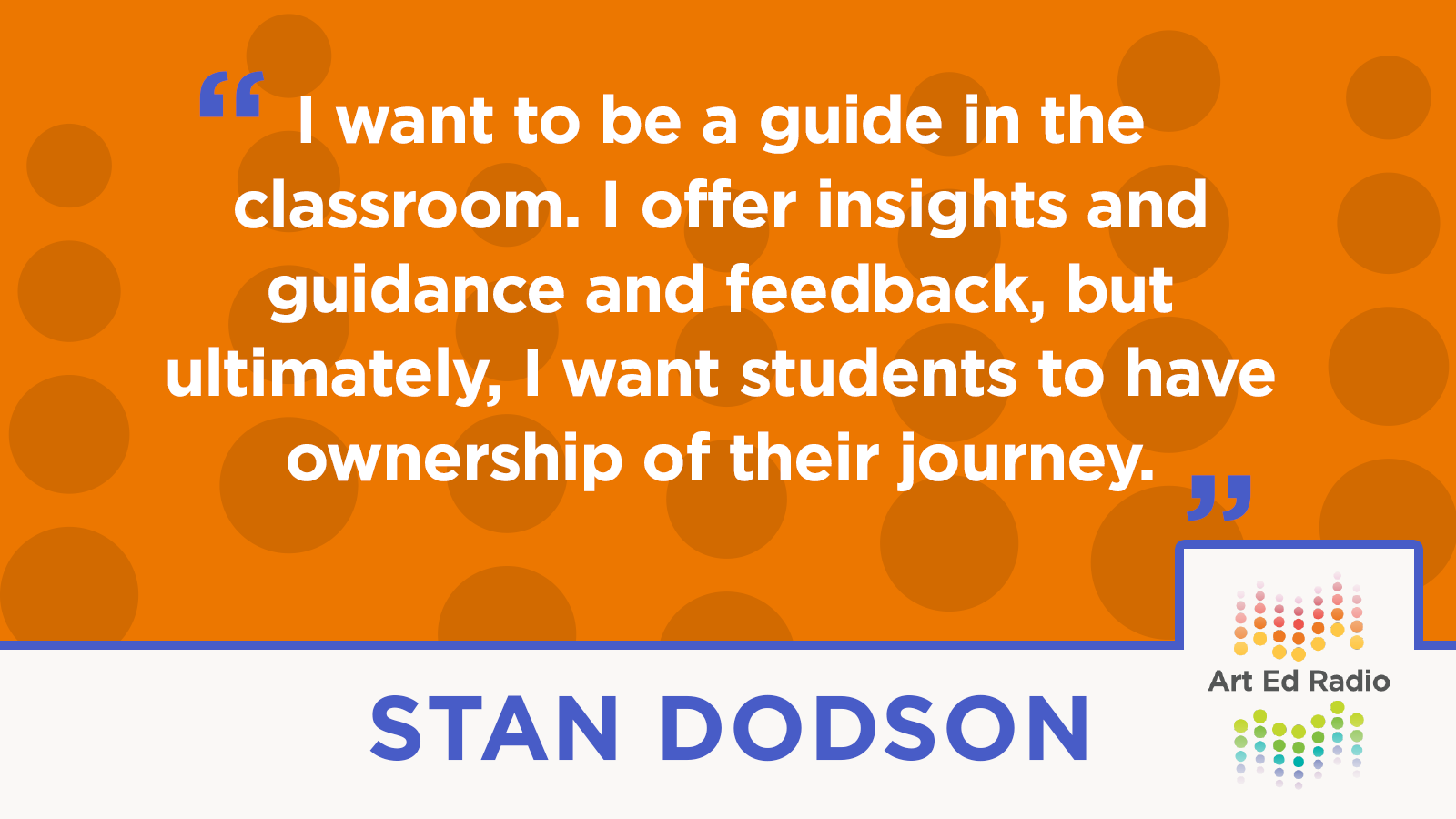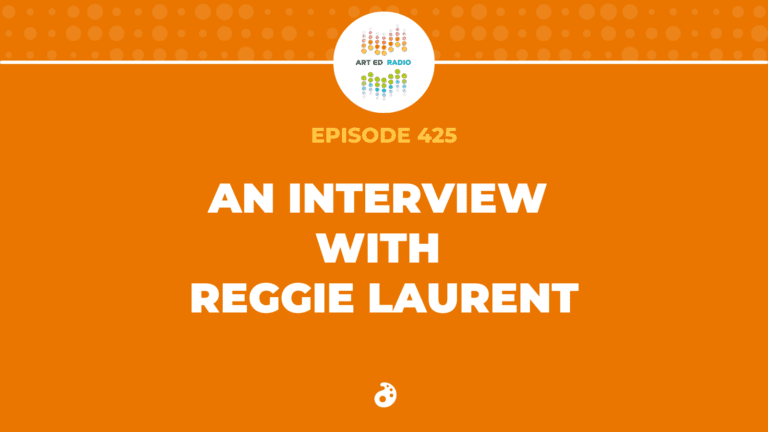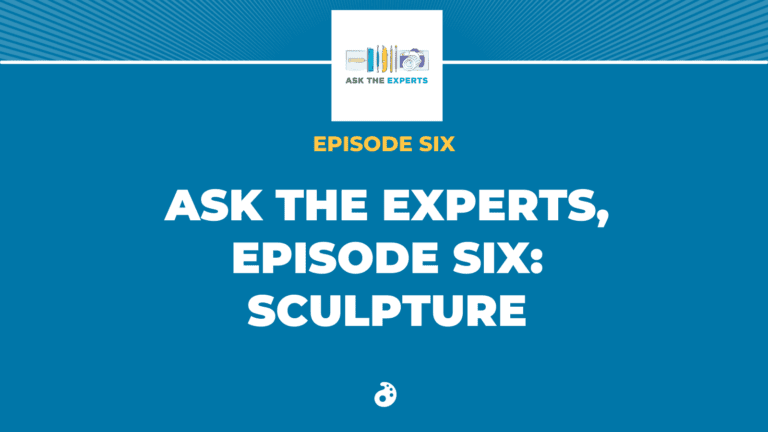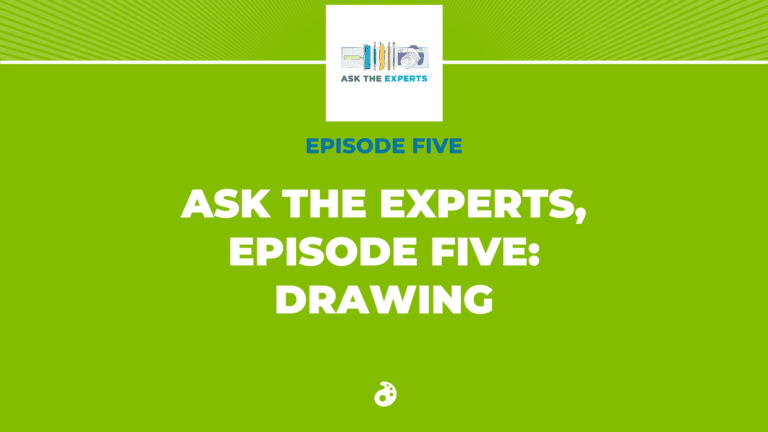This episode from 2019 takes a dive into how we teach drawing. Stan Dodson, art teacher from Augusta, Georgia, joins Tim to talk about how we can encourage kids to take more chances, experiment, and explore in their drawing. Listen as they discuss their favorite drawing projects, ideas for materials and techniques, and the importance of visual journaling. Full Episode Transcript Below.
Resources and Links
- Follow Stan on Twitter
- How to Inspire Students to Use Sketchbooks in a New Way
- 4 Benefits of Trying New Things in Your Classroom
- How to Teach Students to Fail Spectacularly

Transcript
Tim: Hello, Everyone! This is your favorite podcast host, Tim Bogatz. As I said last week, we are taking the opportunity to play a couple of episodes from the podcast archives. If you are dying to listen to something brand new, please check out The Art of SEL, an amazing podcast about social and emotional learning in the art room that is hosted by Jonathan Juravich. And, of course, Nic Hahn publishes the Everyday Art Room podcast every Thursday. You can find them both on the Art of Education University website.
Today’s conversation is with Stan Dodson. Stan is a great high school art teacher from Georgia, a lot of great ideas, and his kids produce some wonderful work. In this discussion, we talk a lot about drawing and some of the creative plans he has for his students. We also talk about diving deep, using visual journals, and really digging into ideas and translating that into work. So here is Exploration and Experimentation in Drawing with Stan Dodson.
Welcome to Art Ed Radio, the podcast for art teachers. This show is produced by The Art of Education University, and I’m your host, Tim Bogatz.
As our students go through their educational experience, far too often they are taught that questions have one right answer. They begin to internalize that there’s one way to do things, and their grades are the end all, be all, the things that define their learning.
I think we can agree on two things. One, that’s not right. Two, art class is the perfect place to have kids recalibrate their thinking, to explore, to experiment, and to learn that there are multiple ways to answer a question, and multiple ways to get to each answer. We can show kids that it’s okay to fail, and teach them that as long as they learn something from the process, they can utilize that learning in the future.
Honestly, we need to fail. When our kids are failing and then, coming back from that, when they’re picking themselves back up, and that is leading, to them, building resilience, and building problem-solving skills. I think creating that safe space in our classrooms, in order to fail, give kids the chance to fail, and to come back to pick themselves up, and that is so important. That’s going to be part of our discussion today, as well.
Coming on the podcast for the first time ever is Stan Dodson. He is a high school teacher from Georgia, and he’s doing a lot of wonderful things with his kids. We’ve been working with him behind the scenes for a few things with AOEU, and he is awesome. Great ideas, great teaching, his kids produce great work. You can check him out on Twitter, @TheArtManStan. We’ll link to that, of course. I think you’ll like what you see there. And I think you’ll enjoy hearing from him today on the show.
But before Stan joins me, I want to share something exciting with you. The Art of Education University is offering its Art Therapy graduate course for the very first time, starting on October 1st, which is really soon. You have to sign up this week. If you’re interested in it, stick around until the end of the episode. I’ll give you all the details that you need. But until then, let’s talk to Stan Dodson.
All right, and now, joining me, the first time ever on the podcast, Mr. Stan Dodson. Stan, how are you?
Stan: Hey. I’m doing good. Great, Tim. Thanks for having me on.
Tim: Yeah, I’m really happy that you can make your podcast debut. I think-
Stan: I know, right. Wow!
Tim: We should be able to have a good conversation here. I know there’s a lot for us to talk about. Before we dive into the conversation, though, can you just kind of give everybody a little bit of background, since this is your first time on the podcast? Can you give us an introduction to who you are, what you do?
Stan: Absolutely. It’d be my pleasure. Thank you so much for having me today. I really appreciate this opportunity. I teach in Georgia at a school called Burke County High School. It’s in a little tiny rural community, Waynesboro, which is really close to Augusta, Georgia. Most people, you say Augusta, and they’re like, “Oh yeah, I know where that’s at.”
Tim: Yeah, yeah.
Stan: We got a little golf around here.
Tim: Nice. Now, I know you are really big on the process side, process over product, with your art teaching. Can you talk to me a little bit about why that’s important to you, and then, maybe talk a little bit about how you go about teaching process to your kids?
Stan: Absolutely. I do love the process. I think for a long time, as a student myself and a working artist, process has just been a really important part to who I am. I thought, what better way to bring in some of my own personal artistic insights into my classroom? I think, in a society that places so much emphasis on product, why can’t the process be the product, is what I tell my kids. Shouldn’t we place value on investigation, on exploration, on the journey? Ultimately, I tell my students solid process reflects solid products.
Process, I think, helps students embrace failure, to see failure as a means to grow and not a way to end. I have seen that many students, initially, they have a difficult time working with the expectation of process. From my understanding, maybe it’s standardized testing. Most students, they’re looking for that one best solution or that one best answer. Ultimately, there’s many answers and many solutions. These skills are the skills that we want our students to have in their toolbox of life. Innovative thinking, learning to look beyond the obvious and seeing failure as a means to help propel you through, and not a means to stop you.
Tim: I think that’s really, really well said. I’ve been admiring just all of the kind of cool projects that you do. I know you share a lot on Twitter, and just some great images there, so I wanted to ask you about a couple of those projects. First up, you showed some really cool drawings of doughnuts that your kids were doing.
Stan: Yeah, the doughnuts!
Tim: We need to know whether we eat them or not, but also, more importantly, those are fun drawings, but what do kids learn from those types of drawings? Why do you bring them in, and how do you teach using that as your subject matter?
Stan: I think that’s a really great starting point, because that project in itself is a way that I go about teaching process in a fun little way. Generally, especially with some of my advanced or AP level classes, I do a lot of prompt-based assignments or journal reflections that give them a little bit of open-ended discovery. But sometimes students just have a hard time getting started.
Students become the inquirers, they’re the inquirers through the media, through the process, through the product. Me, myself, I feel like I’m just the guide in the classroom. I just help move students along through what I call the expedition of their artistic journey. I’m just here to offer insights and guidance and feedback, but ultimately, I really want the students to have ownership of their journey.
And this little project, which I call The 50 Doughnuts, it’s something that I adapted from a module I learned at my graduate school time. I assigned a challenge for them to draw 50 doughnuts. The students are given two doughnuts, and of course, one is for them to eat the other one’s for them to draw. So you can’t look at a doughnut for a whole couple of days and not eat one, right?
So they have to eat one. So I then tell them, “Now, you get to draw the doughnut 50 times.” At first, students are like, “Yeah, this is easy. I got this.” But come, I’d say, I don’t know, number 12, they start to hit that figurative wall. And that’s exactly what I want. I want them to go ahead and turn out all those obvious solutions, like graphite marker, and colored pencil, because then they can begin to look for more innovative ways to just make a mark and innovative ways to create that mark.
I say, “Hey, what would happen if you draw the doughnut with a mascara wand, using coffee or a paper clip?” The solutions, they’re so varied, they’re so open-ended, and from the many, a few will reveal personal voice and innovation. I like to tell the students, “Let’s just use the 10% rule. Do many and typically 10% emerge as relevant.” In the end, it’s not about the doughnut at all, it’s about the process.
It helps students embrace process and discovery on a small, tangible level. And hopefully, they build and learn to take risks and elevate their thinking, from the obvious to the exceptional. And I tell my students this a lot about spaghetti. I say, “This is kind of a learned skill, is process. Think about what we do compared to cooking spaghetti, to see if it’s done. Sometimes you have to throw it against the wall. If it sticks, you’re good to go.”
So, when developing ideas, sometimes you have to throw crazy things out there, and it might stick, and it might not. But from the many, something will be revealed, and in some 50 doughnuts, hopefully five emerge as something that’s evocative, that’s personal, that’s innovative. And the kids love it. They love looking at doughnuts.
Tim: Yeah, well, as long as they get to eat one, anyway, they love it.
Stan: It’s the part where I get to tell them, “You know that Ziploc bag with the doughnut in it, that we stored in the drawer?” Yeah. Two weeks later, “It’s still there, guys. We got to get those.” There’s a whole ‘nother process thing happening in that drawer now.
Tim: Yeah. That’s funny. So let me ask you, then, do you see that sort of experimental mark-making, does that take hold with bigger drawings that they do? Or is that something that is continuing to develop with some other ideas, as you move throughout the semester, or throughout the year?
Stan: I think it’s, yeah, absolutely. I think it’s absolutely embraced, and I think it’s partly because of the environment that we try to nurture. And thus, from that environment, we try to cultivate a way to think and do. And so, we see the kids learning to embrace risk-taking and to see failure as a way, or a means to get to the end product because no one likes the word failure.
Tim: Right.
Stan: But we just try it as trials, or experiments, or ways to see through, and push through. It helps them develop a really good work ethic, too. And I think that that, that is one of those skills that moves them into the 21st Century, well beyond just being an artist. This is being a really good thinker and person of the world and the community.
Tim: Oh, yeah, absolutely. And just even, I don’t know, bringing it back from the whole idea of what’s going on beyond, just trying to finish things, just in class. Let’s say, you have a portfolio to put together for college, or an AP portfolio that you’re trying to do. Not everything is going to be super fun and super exciting to work on. Sometimes you just need to grind it out and just get it done, and-
Stan: Absolutely.
Tim: Do it. And if you can develop those habits, it can be so beneficial for them.
Stan: It is. It is definitely that. And that really makes me think of a quote from, from Chuck Close, because I love to use that, talking about, like, the kids are always sitting around waiting for like a lightning bolt to hit them, or for them to find their muse. And mostly, it’s just like Chuck Close would say, “Don’t wait awhile for inspiration at all. Inspiration’s for amateurs. The rest of us just show up and get to work. The real ideas come from the process, from really just doing the work.”
Tim: I use that quote all the time, as well. It’s a good one. Now another project that you were showing, you had a lot of images of this, I was really fascinated by that. It was your black and white, or maybe your ebony and ivory drawings? Can you describe the process of those?
Stan: Absolutely.
Tim: And what you want, I guess, what you want kids to learn from those? I know one is constructive, one is reductive. Can you just talk about that a little bit?
Stan: For sure. I find that when the students come back from their summer break, they haven’t been as active with their art making. And some of the technical skill, yeah, surprise, surprise. Some of the skills have kind of fallen aside. It’s like playing a trumpet. If you, you don’t play it for two and a half months, you’re not going to sound great. So we, I use this still life as a way for them to get some of their technical skills back, and a way for them to maybe develop a little bit of integrating some personal voice.
So, for the first still life, it’s all about the egg. I take, I give each student an egg, and they have to put a little hole in it, and drain the yolk from it. And they get to set up their own personal all-white still life, which is kind of fun.
They get to choose from China pieces and a spoon or the egg. And I tell them, “Think about the egg. What could the egg represent? Because there’s so much that you can look into the egg, and it can be fairly open-ended.” And then they set up their own still life lights, and each day, they’re drawing on white paper, using a limited palette, other than the graphite, maybe some charcoal, for them to really hone in on trying to find a way to create a composition that’s striking, that presents it in really high contrast.
And so, they’re real familiar with the additive concept, and just immediately after that white still life, we move right into the all black still life. So, then we’re working from the round, in which I’ve created a central still life in the middle of the room.
And I spraypaint various objects, like a bicycle and a stool, and a lamp, and books. And it’s all spraypainted black. And then we spotlight it. And then their job is to look through little viewfinders, to find really strong compositions, and do an additive process, where they’re adding into the piece, using just white pencil on black paper. And it’s challenging for them to really do that, to really go from looking at something that’s white to looking at something that’s all black.
It’s like some of those old, drawing from the right and left side of the brain. They have to use those, both sides of those thinking skills, to look at those shapes and values. And then maybe think about mark-making at the same time, and presenting compositions that maybe speak to more than just a still life. How are you arranging it? How are the shadows falling, and why are you telling that story in that manner, in that way?
It really tries to open the students up to looking beyond the obvious of, “This is not just an egg. This egg represents purity, or birth, or nurturing, or lots of different ways in which you arrange that still life.” So it presents a lot of great products, but ultimately, the students find success through their product, their process.
Tim: Yeah, that’s awesome. No, I think that’s a really good description of how you go about that. I love the idea of just spraypainting everything black, and letting them deal with it.
Stan: Yeah, it’s so much fun. We’re like, “Hey, let’s put this in there,” and just spraypaint it, so… And there are different levels of success. You’ve got to walk around the room, like, “Yeah, the bicycle’s pretty hard. I’m going to go stick over here with that student.”
Tim: Yeah, yeah, it’s differentiation, right? Finding different levels.
Stan: Absolutely, but it’s a lot of fun. It’s a lot of fun. But they walk in that room, and it’s all lit, and it’s black, and it’s like, “Oh, okay. So we’re doing this now.”
Tim: Yeah. You’re getting great results from it, though, so, and then, the other thing that I really wanted to ask you about, I know you’re huge on visual journals-
Stan: Yeah!
Tim: That’s something we talk a lot about on the podcast here, so I guess, I would just love your input, as far as how you use those. Like I said, a safe place for kids to experiment. Do you want something more? Is it that investigation, experimentation idea, the trial run that you’re talking about? Or do you encourage finished works in there, as well?
Stan: For sure. Those are all really good questions to ask about the visual journals. We, I do love the visual journal. I think it’s a place that I want the students to feel, one, safe to explore in, and to able to find that place that they can take that risk, that they can learn to take chaos and try to control it somehow. Either through an emotional aspect, or a technical aspect, where they’re trying to refine maybe a skill development.
And so, I try to balance my book between technical and reflective, open-ended responses, where it maybe had even more of a narrative component to it, where they have to write or respond in some kind of narrative component. Some students, they write poetry, they write journal entries, they’ll do songs that respond to them, and then somehow put visual components in there.
And I leave it very open-ended. I want them to say, “Hey, collage is an element of design, transfer tracing, why not put it in your book photography? Sure. Excellent. Let’s do that.” I want them to feel safe. I want to feel like this is a place for their voice.
And sure, I’ll go back to these pages, like, “You remember that page you did? It was, it had some really great watercolor technique. I think that you should use this almost like, as a thumbnail comp, and work this piece up again. You’re trying to come up with this idea, and I think the idea already lives and breathes right here in your journal. You forgot about it.” And so, to make that a part of who they are as artists, the journal, the thumbnail, the sketchbook, it is a living, breathing document, I think.
Tim: Yeah, that’s really well said. And I think that’s a powerful idea, of just letting kids have that safe space to develop voice. And I think that’s a really worthwhile goal, so… Well, all right. Well, Stan, I think we’re about out of time, so we’ll go ahead and wrap it up there.
But thank you so much for taking some time to talk to me. I’m really glad you could make it on, and hopefully we’ll have you back again soon.
Stan: All right, I look forward to it. This is a lot of fun.
Tim: All right, big thank you to Stan for coming on, for discussing some of his ideas when it comes to drawing, and really helping us explore some of those ideas by sharing what he does in his classroom. And I think this type of discussion is really valuable, because too often teachers pay a lot of lip service to process and exploration and experimentation, but rarely talk about how they teach it, or the specifics, or how they encourage students to do so.
So I think having some concrete examples from Stan is incredibly helpful here. And I’m glad we were able to have that conversation today. And like I said, we’ll need to have him on again, because I think there’s a lot more there that we can explore.
Then before we go, let’s talk Art Therapy. As I said in the intro, this course begins its first section on October 1st. This means, if you’re interested, that you will need to sign up by the 27th. That’s Friday, that’s three days away. You can go to theartofeducation.edu/courses, to check it out, and see all of the information that you need, whether you’re just curious, or whether you’re ready to sign up. It’s all there.
So Art Therapy will be a three-credit hour course that runs for eight weeks. It is a course that is designed to help you gain an understanding of the role of art therapy, the role of art therapists, and how those roles compare to what we do as art educators. You’ll learn about strategies to help you foster self-esteem and self-awareness, cultivate emotional resilience, and promote creative insight with yourself and with your students. So if you have questions or want to sign up, again, head to theartofeducation.edu/courses.
Art Ed Radio is produced by The Art of Education University, with audio engineering from Michael Crocker. We will be back next week with Dr. Wynita Harmon, and a discussion on social and emotional learning in the art room. We’ll talk to you then.
Magazine articles and podcasts are opinions of professional education contributors and do not necessarily represent the position of the Art of Education University (AOEU) or its academic offerings. Contributors use terms in the way they are most often talked about in the scope of their educational experiences.



